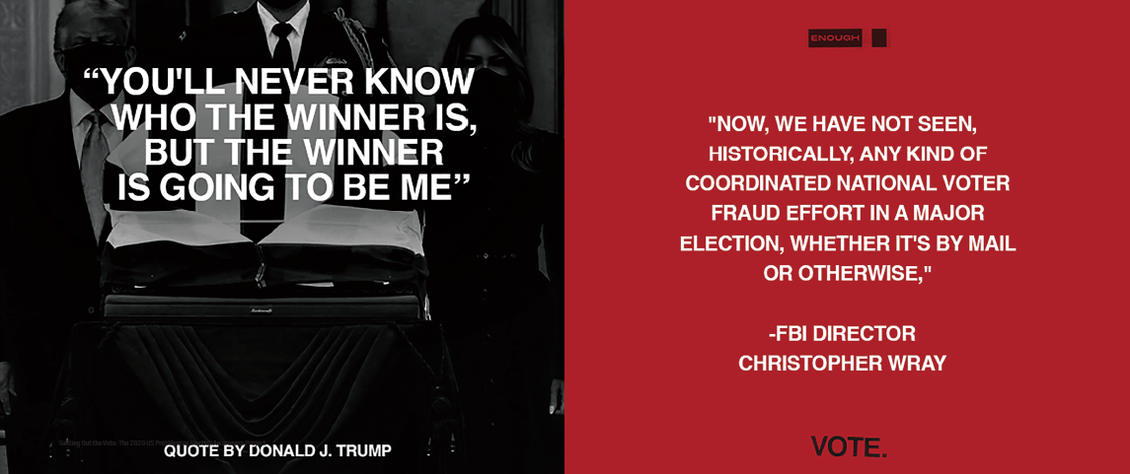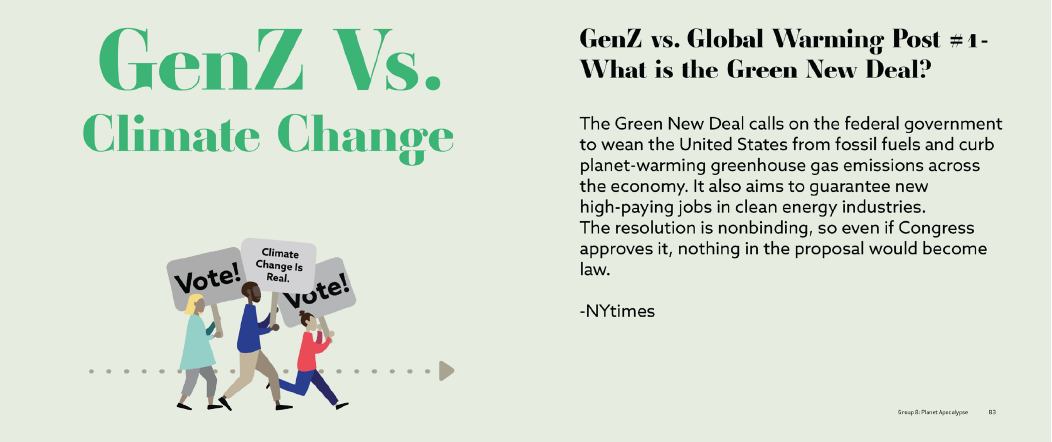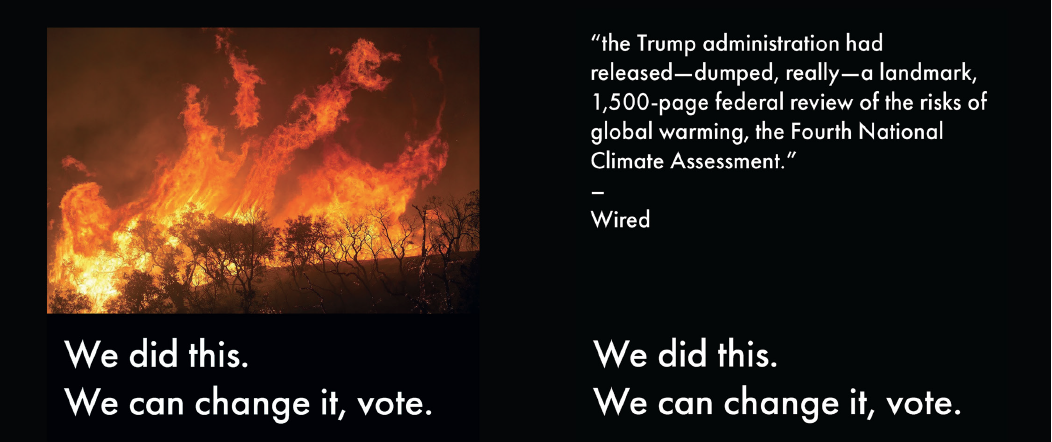Getting Out the Vote: The 2020 US Presidential Election Awareness Project
Posted February 1, 2021, 10:50 AM
Updated February 1, 2021, 10:58 AM
by Steve Jones / Agitprop: Issues and Causes

Enough Bullshit
Sony Maharjan / Cameron Terrones
I’ve been teaching the Agitprop: Issues and Causes class since the fall of 2018...
Every semester started off with a fun exercise - a take on the Donald Trump fueled phrase, “Make America Great Again” (MAGA). The phrase, like the man, has been one of great division—it assumes that the current (more open, inclusive, browner) state of America represents one of decline. The challenge with the exercise was for each student to come up with five (or more) takes on MAGA. Their solutions could be serious, nonsensical, absurd, contemplative, abstract—but the ultimate goal was to have fun (e.g. Mostly Great, Generally Abrasive; Manic Assholes Govern America; Make America Go Away), while at the same time, critiquing what it means to “Make America Great Again.”
But, with the (consequential) November 2020 election around the corner, and surveys showing that many Americans were not confident the country could hold a fair election—I felt that I needed to do a project that was a little more substantial. Prior to the fall semester, I had been in casual talks with Prof. Kim Anno about a future class collaboration. As it happened, Prof. Anno was thinking of doing a project around voting and the general election with her Citizen’s Artists/Designers/Journalists studio. Around the same time, I found out that my CCA@CCA Faculty Micro Grant was awarded, and I contacted Prof. Anno about a collaboration between our two classes - The result was Getting Out the Vote: The 2020 US Presidential Election Awareness Project.

Racial Income Inequality
Nero Guo / Chaitanya Khurana / Sakshi Shah
I put together a course assignment, and met with Prof. Anno to discuss a timeline and structure. In order to complete the projects before election day, I developed a 4-week timeline—which gave us enough time to get the work out into the world, at least a month before the November 3rd election. We decided that the central question to push the project would be: What are the issues that will drive you to the polls in 2020? Issues such as healthcare, terrorism, national security, gun policy, education, the economy, immigration, climate change, reproduction rights, distribution of income and wealth in the U.S., the federal budget deficit , taxes, race relations, infrastructure, college costs, foreign affairs, trade issues, LGBTQ rights…
For maximum impact, and manageability we grouped students from both classes into ten teams (of 2-4). The goal for each team was to focus on an issue of particular concern for the upcoming 2020 US Presidential Election. Each team had to choose an audience (youth, elderly BIPOC, queer, Independents, Democrats, Republicans, etc.), and create a targeted response. In the Agitprop: Issues and Causes class, the poster (or printed matter) is generally (and historically) the preferred means to disseminate a message to the general public. But due to COVID-19, where the maximum impact of public spaces, and street traffic was reduced—we opened solutions (in addition to print) to include alternative outcomes, e.g. social media, an app, the mail, etc.

Planet Apocalypse
Louella Evans / Astrid Hernandez / Aaron Weeks
In order to get a message across, a well-crafted narrative is key. The foundation of Agitprop: Issues and Causes is propaganda and how it is used to craft and spread a message. Propaganda and graphic design go hand-in-hand. Throughout human history, there have been those who subversively or overtly critique/attack an institution, ruling power, religion/religious leaders, politics, or the imposed conventions of a society/culture. What these actions all have in common, is that it speaks to some truth, a truth that irritates/condemns or praises the depicted subject/institution. In order to help the teams formulate their ideas, I invited Design Action Collective (DAC) to Zoom with the students. DAC is an Oakland-based co-operative that provides graphic design and visual communications for progressive, non-profit, and social change organizations—that aim to help build and strengthen progressive movements fighting for economic and social justice. Sabiha Basrai and Joy Liu-Trujillo talked about DAC’s work, and discussed a couple of case studies.
Each team’s approach to their issue could be either pro, or con—with the goal to create a response that is effective and persuasive—generating media that had the ability to persuade (change/challenge opinion/s). Teams began by brainstorming and researching existing responses to their problem. They were to identify characteristics that they felt were successful, and characteristics that they felt fell short in communicating to the target audience—and to think about a message that was poetic vs. dialectic; and covert vs. overt (or a combination of both).
At the close of the campaign, each team’s process and final project were collected and printed in the book Getting Out the Vote: The 2020 US Presidential Election Awareness Project.

We Did This, We Can Change It
Howsen Huang / Scott Underwood